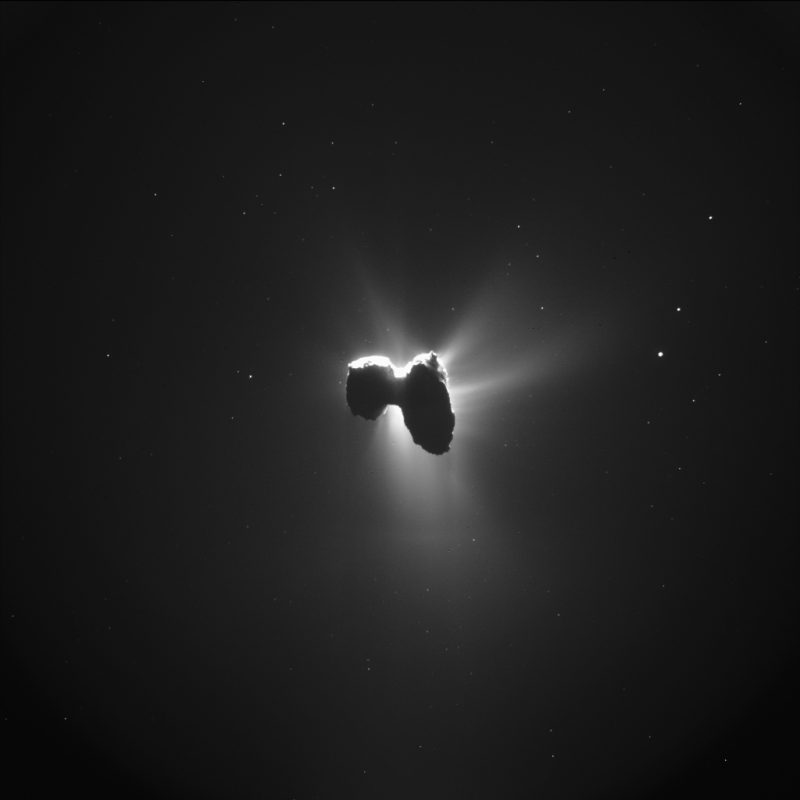
Famous comet 67P is approaching
One of the best-studied comets is 67P/Churyumov-Gerasimenko. The European Space Agency’s Rosetta spacecraft rendezvoused with it in August of 2014. Before the year ended, in a first, the mission had sent its Philae lander to the comet’s surface. Overall, the spacecraft traveled with the comet for two years. Comet 67P/C-G is currently approaching Earth, getting a bit closer and brighter each day. Observers are already aiming backyard telescopes its way, and more will seek this comet in the sky between now and its closest approach on November 11-12, 2021. There is no danger. At its closest, the comet will pass more than 38 million miles (61 million km) from Earth, between the orbits of Earth and Mars. But what fun to see this venerable comet through an earthly telescope! And it’ll be 67P’s closest approach for the next 193 years, until November 16, 2214.
67P/Churyumov-Gerasimenko is an ordinary comet, with a close orbit around the sun. Soviet astronomers Klim Ivanovych Churyumov and Svetlana Ivanovna Gerasimenko discovered it on October 22, 1969. It requires only 6.43 years to orbit the sun once, making it an attractive target for spacecraft. Its nucleus is an estimated 2.6 miles (4.2 km) wide. Like many of the small, icy comets in our solar system, 67P has two distinct lobes. Astronomers believe double-lobed comets like this one formed during slow collisions of icy debris, in the early stages of our solar system’s formation, some 4.5 billion years ago.
Comet 67P’s 2021 perihelion – closest point to the sun – will take place on November 3. Its exact time of closest approach to Earth is November 12, 2021 at 00:50 UTC on November 12 (translate UTC to your time).
Rosetta’s visit to 67P
ESA’s Rosetta spacecraft mission – named for the Rosetta Stone that was an invaluable tool for deciphering ancient Egyptian scripts – was a ground-breaking comet mission. It was the first to include an orbiter that accompanied the comet as it sped through space for a year prior to its August, 2015, perihelion (closest point to the sun). The spacecraft also stayed with the comet for a second year, after perihelion, as it began heading outward away from the sun again. The Rosetta mission’s lander was named Philae for an ancient Egyptian obelisk. When Philae landed on the surface of 67P on November 12, 2014, it was the first spacecraft ever to land on a comet. Philae landed in one piece, but bounced in the comet’s low gravity. They found it a month later.
All in all, it’s hard to overstate the impact of the Rosetta mission on our knowledge of comets. Much of what scientists thought was true about them did prove true. For example, we had long pictured gases venting from a comet’s small nucleus, as its orbit brought closer to the sun. But to see the gases venting from comet 67P’s nucleus in images from Rosetta … it was beautiful and wonderful!
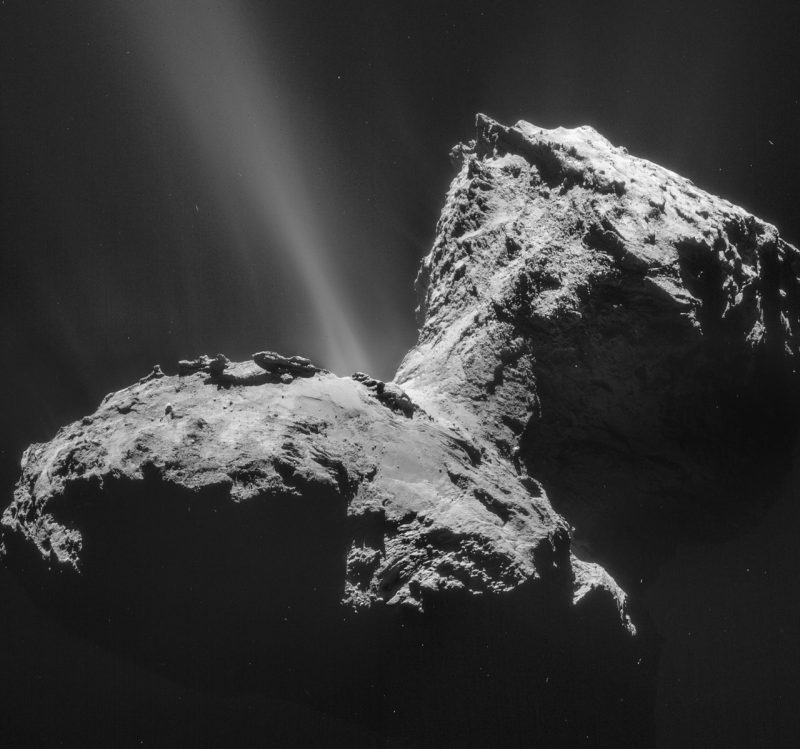
67P/ Churyumov-Gerasimenko. Image via ESA’s Rosetta spacecraft/ NASA.
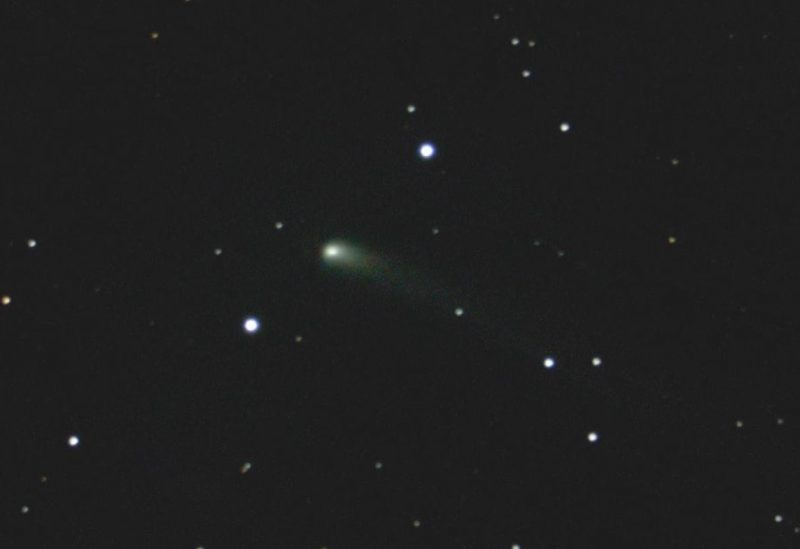
How to see famous comet 67P
Although the comet is gradually brightening, unfortunately it won’t get bright enough to see with the unaided eye at its 2021 sweep past Earth. But, at its brightest, it will be around magnitude 9 to 10, well within the reach of visual observations using amateur telescopes, and an easy target for those whose small telescopes equipped with cameras.
Comet 67P/Churyumov-Gerasimenko will be fascinating to view in backyard telescopes. As you gaze upon it, you’ll know this chunk of rock and ice has been visited by a robot spacecraft, sent by humanity. The charts below can help you find comet 67P.

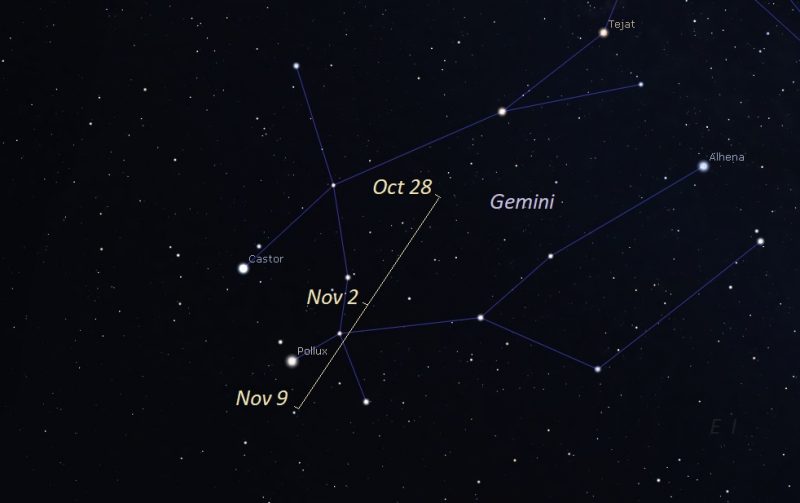
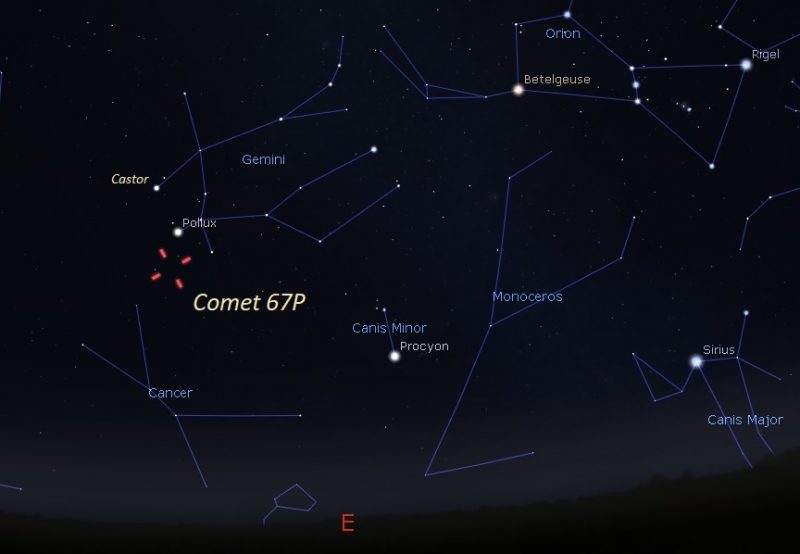
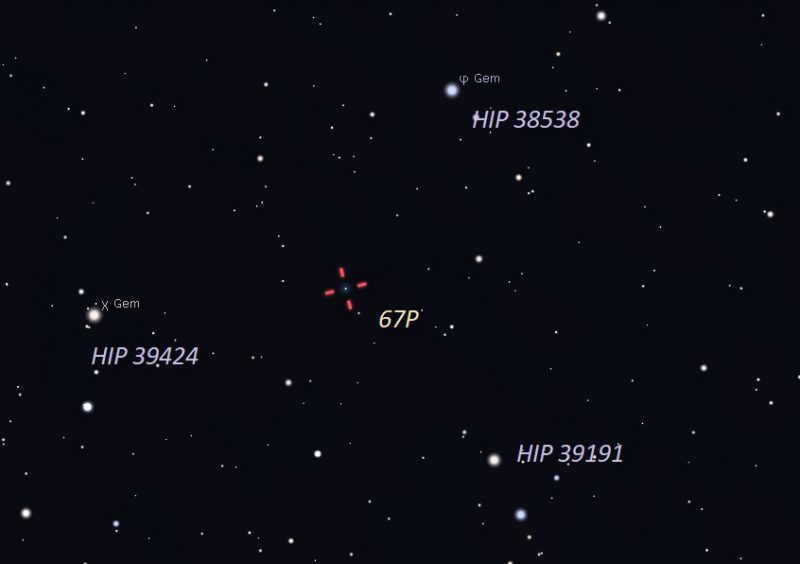
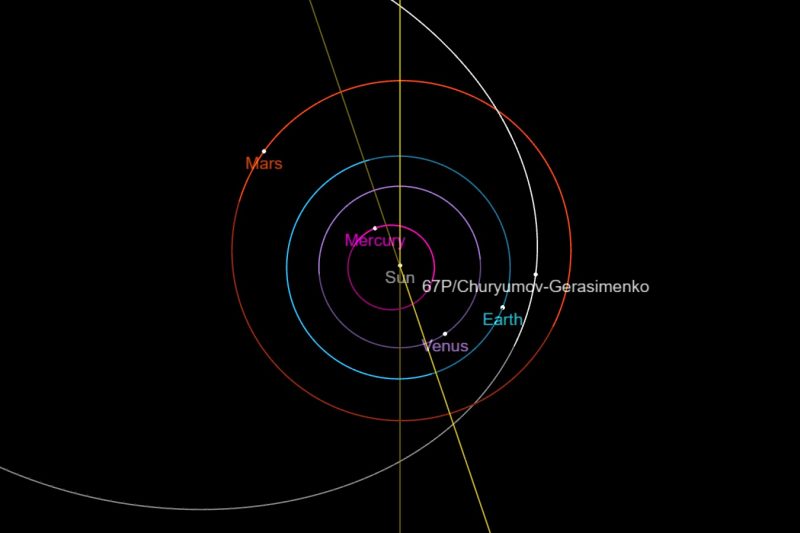
Holding out for a bright comet?
Still waiting for a good binocular or perhaps even a comet visible to the eye alone? Another comet, C/2021 A1 (Leonard), might become this years’ brightest comet. More details on Comet Leonard here.
Bottom line: Famous comet 67P/C-G will sweep closer to Earth in the coming months. Amateur telescopes are already aimed its way. Charts and more here.
The post Famous Comet 67P/C-G will be closest until 2214 first appeared on EarthSky.
from EarthSky https://ift.tt/3EO3D4B

Famous comet 67P is approaching
One of the best-studied comets is 67P/Churyumov-Gerasimenko. The European Space Agency’s Rosetta spacecraft rendezvoused with it in August of 2014. Before the year ended, in a first, the mission had sent its Philae lander to the comet’s surface. Overall, the spacecraft traveled with the comet for two years. Comet 67P/C-G is currently approaching Earth, getting a bit closer and brighter each day. Observers are already aiming backyard telescopes its way, and more will seek this comet in the sky between now and its closest approach on November 11-12, 2021. There is no danger. At its closest, the comet will pass more than 38 million miles (61 million km) from Earth, between the orbits of Earth and Mars. But what fun to see this venerable comet through an earthly telescope! And it’ll be 67P’s closest approach for the next 193 years, until November 16, 2214.
67P/Churyumov-Gerasimenko is an ordinary comet, with a close orbit around the sun. Soviet astronomers Klim Ivanovych Churyumov and Svetlana Ivanovna Gerasimenko discovered it on October 22, 1969. It requires only 6.43 years to orbit the sun once, making it an attractive target for spacecraft. Its nucleus is an estimated 2.6 miles (4.2 km) wide. Like many of the small, icy comets in our solar system, 67P has two distinct lobes. Astronomers believe double-lobed comets like this one formed during slow collisions of icy debris, in the early stages of our solar system’s formation, some 4.5 billion years ago.
Comet 67P’s 2021 perihelion – closest point to the sun – will take place on November 3. Its exact time of closest approach to Earth is November 12, 2021 at 00:50 UTC on November 12 (translate UTC to your time).
Rosetta’s visit to 67P
ESA’s Rosetta spacecraft mission – named for the Rosetta Stone that was an invaluable tool for deciphering ancient Egyptian scripts – was a ground-breaking comet mission. It was the first to include an orbiter that accompanied the comet as it sped through space for a year prior to its August, 2015, perihelion (closest point to the sun). The spacecraft also stayed with the comet for a second year, after perihelion, as it began heading outward away from the sun again. The Rosetta mission’s lander was named Philae for an ancient Egyptian obelisk. When Philae landed on the surface of 67P on November 12, 2014, it was the first spacecraft ever to land on a comet. Philae landed in one piece, but bounced in the comet’s low gravity. They found it a month later.
All in all, it’s hard to overstate the impact of the Rosetta mission on our knowledge of comets. Much of what scientists thought was true about them did prove true. For example, we had long pictured gases venting from a comet’s small nucleus, as its orbit brought closer to the sun. But to see the gases venting from comet 67P’s nucleus in images from Rosetta … it was beautiful and wonderful!

67P/ Churyumov-Gerasimenko. Image via ESA’s Rosetta spacecraft/ NASA.

How to see famous comet 67P
Although the comet is gradually brightening, unfortunately it won’t get bright enough to see with the unaided eye at its 2021 sweep past Earth. But, at its brightest, it will be around magnitude 9 to 10, well within the reach of visual observations using amateur telescopes, and an easy target for those whose small telescopes equipped with cameras.
Comet 67P/Churyumov-Gerasimenko will be fascinating to view in backyard telescopes. As you gaze upon it, you’ll know this chunk of rock and ice has been visited by a robot spacecraft, sent by humanity. The charts below can help you find comet 67P.





Holding out for a bright comet?
Still waiting for a good binocular or perhaps even a comet visible to the eye alone? Another comet, C/2021 A1 (Leonard), might become this years’ brightest comet. More details on Comet Leonard here.
Bottom line: Famous comet 67P/C-G will sweep closer to Earth in the coming months. Amateur telescopes are already aimed its way. Charts and more here.
The post Famous Comet 67P/C-G will be closest until 2214 first appeared on EarthSky.
from EarthSky https://ift.tt/3EO3D4B

Aucun commentaire:
Enregistrer un commentaire